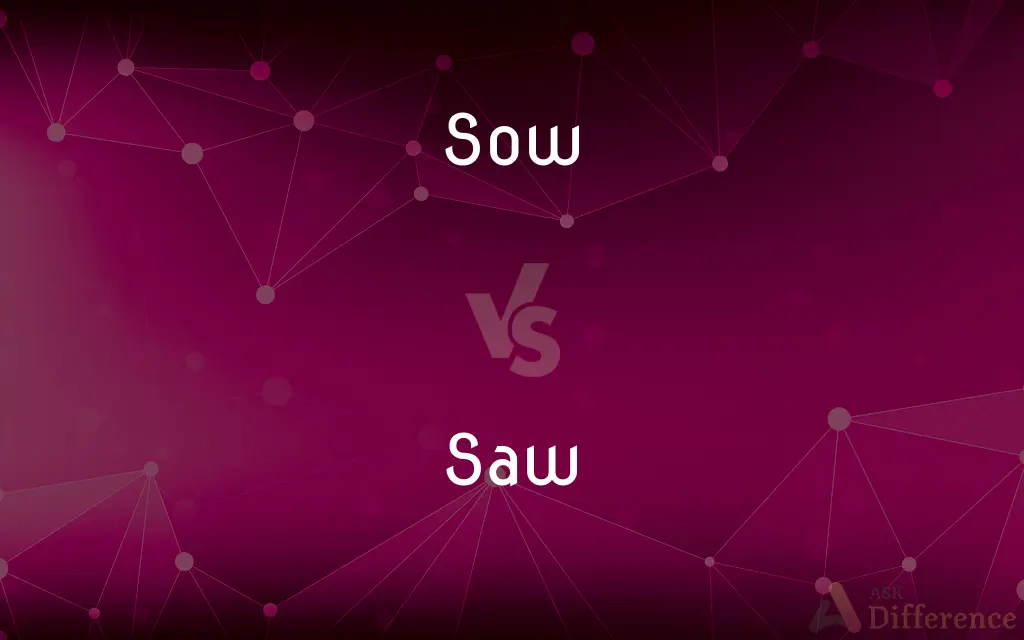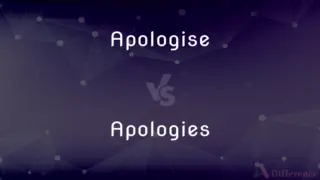Sow vs. Saw — What's the Difference?
By Tayyaba Rehman & Maham Liaqat — Updated on April 7, 2024
"Sow" refers to planting seeds or scattering them over the ground, while "saw" is the past tense of "see," indicating the action of perceiving with the eyes.

Difference Between Sow and Saw
Table of Contents
ADVERTISEMENT
Key Differences
"Sow" is a verb that means to plant or scatter seeds in or on the earth, a fundamental agricultural practice aimed at cultivating various plants and crops. This action involves either manual or mechanical distribution of seeds into the soil to ensure their growth into mature plants. On the other hand, "saw" serves as the past tense of the verb "see," which describes the act of noticing or observing something using the eyes. It is used to recount experiences or events that were visually perceived in the past.
While "sow" is directly related to the act of planting seeds for future growth, highlighting a process of beginning and potential, "saw" connects to the sense of sight and the ability to perceive or witness events, emphasizing an experience that has already occurred. The difference between these terms extends beyond their definitions to their use in language: "sow" is used in contexts related to agriculture, gardening, and metaphorical expressions of starting or initiating, whereas "saw" is broadly used to describe the experience of seeing something in the past.
In practical use, "sow" often involves planning and preparation, as in determining the right time and method for planting to ensure the best growth conditions for the seeds. It implies an investment in the future, whether in farming, gardening, or figuratively speaking about planting ideas or initiatives. Conversely, "saw" is retrospective, looking back at what has been observed or experienced, often leading to reflections, conclusions, or sharing information about past visuals.
The distinction also touches on the different aspects of human interaction with the world: "sow" is about actively engaging with the environment to influence future outcomes, while "saw" is about passively recording or experiencing what has already happened. This difference highlights the active versus passive roles played in various contexts, from literal farming and gardening to metaphorical applications in planning and reflecting on experiences.
Both terms, despite their differences, play significant roles in language, each carrying a wealth of metaphorical and literal meanings that enrich communication. Whether discussing the physical act of planting seeds with "sow" or recounting visual experiences with "saw," these verbs facilitate a diverse range of expressions and insights into human activities and perceptions.
ADVERTISEMENT
Comparison Chart
Definition
To plant seeds in the ground for growth.
Past tense of "see," meaning to perceive with the eyes.
Context
Agriculture, gardening, metaphorical for beginning something.
Describing past visual experiences or observations.
Action Type
Active engagement with the environment.
Passive recording or experiencing of events.
Tense
Present (also has past tense "sowed").
Past.
Implication
Investment in the future, initiation.
Reflection on or sharing of past experiences.
Compare with Definitions
Sow
To scatter or spread objects or elements.
The wind sowed the leaves across the lawn.
Saw
To understand or comprehend through observation.
After reviewing the evidence, she saw the truth of the matter.
Sow
Act of planting for agricultural or gardening purposes.
It's time to sow the garden with herbs and vegetables.
Saw
To imagine or envision a particular way.
I saw myself living in that house one day.
Sow
To plant seeds by scattering them on or in the earth.
In spring, farmers sow seeds in their fields.
Saw
Past tense of "see," having perceived with the eyes.
We saw a shooting star last night.
Sow
To initiate or begin something that will grow or develop.
The program was designed to sow the seeds of friendship between the two communities.
Saw
To have witnessed or observed something.
He saw the accident happen from his window.
Sow
To introduce or disseminate ideas or information.
The speaker sowed doubt among the audience with his questions.
Saw
To visit or attend as a spectator.
They saw a play at the local theater.
Sow
To scatter (seed) over the ground for growing.
Saw
A saw is a tool consisting of a tough blade, wire, or chain with a hard toothed edge. It is used to cut through material, very often wood though sometimes metal or stone.
Sow
To scatter seed over (land, for example).
Saw
Any of various tools, either hand-operated or power-driven, having a thin metal blade or disk with a sharp, usually toothed edge, used for cutting wood, metal, or other hard materials.
Sow
To strew something around or over (an area); distribute something over
"The yard was sown with cement sculpture" (Ashley Warlick).
Saw
A familiar saying, especially one that has become trite through repetition.
Sow
To propagate; disseminate
Sow rumors.
Saw
To cut or divide with a saw.
Sow
To scatter seed for growing.
Saw
To produce or shape with a saw
Sawed a hole in the board.
Sow
A channel that conducts molten iron to the molds in a pig bed.
Saw
To make back-and-forth motions through or on
A speaker who saws the air with his arms.
Sow
The mass of metal solidified in such a channel or mold.
Saw
To use a saw
Sawing along the chalk line.
Sow
A female pig.
Saw
To undergo cutting with a saw
Pine wood saws easily.
Sow
A female bear, she-bear.
Saw
Past tense of see1.
Sow
A female guinea pig.
Saw
A tool with a toothed blade used for cutting hard substances, in particular wood or metal.
Sow
A channel that conducts molten metal to molds.
Saw
Such a tool with an abrasive coating instead of teeth.
Sow
A mass of metal solidified in a mold.
Saw
A musical saw.
Sow
A contemptible, often fat woman.
Saw
A sawtooth wave.
Sow
A sowbug.
Saw
(obsolete) Something spoken; speech, discourse.
Sow
(military) A kind of covered shed, formerly used by besiegers in filling up and passing the ditch of a besieged place, sapping and mining the wall, etc.
Saw
(archaic) A saying or proverb.
Old saw
Sow
(ambitransitive) To scatter, disperse, or plant (seeds).
When I had sown the field, the day's work was over.
As you sow, so shall you reap.
Saw
(obsolete) Opinion, idea, belief.
Sow
(figurative) To spread abroad; to propagate.
Saw
(obsolete) Proposal, suggestion; possibility.
Sow
(figurative) To scatter over; to besprinkle.
Saw
(obsolete) Dictate; command; decree.
Sow
Obsolete spelling of sew
Saw
(transitive) To cut (something) with a saw.
Sow
To sew. See Sew.
Saw
(intransitive) To make a motion back and forth similar to cutting something with a saw.
Sow
To scatter, as seed, upon the earth; to plant by strewing; as, to sow wheat. Also used figuratively: To spread abroad; to propagate.
A sower went forth to sow; and when he sowed, some seeds fell by the wayside.
And sow dissension in the hearts of brothers.
Saw
(intransitive) To be cut with a saw.
The timber saws smoothly.
Sow
To scatter seed upon, in, or over; to supply or stock, as land, with seeds. Also used figuratively: To scatter over; to besprinkle.
The intellectual faculty is a goodly field, . . . and it is the worst husbandry in the world to sow it with trifles.
[He] sowed with stars the heaven.
Now morn . . . sowed the earth with orient pearl.
Saw
(transitive) To form or produce (something) by cutting with a saw.
To saw boards or planks (i.e. to saw logs or timber into boards or planks)
To saw shingles
To saw out a panel
Sow
To scatter seed for growth and the production of a crop; - literally or figuratively.
They that sow in tears shall reap in joi.
Saw
Something said; speech; discourse.
Sow
The female of swine, or of the hog kind.
Saw
A saying; a proverb; a maxim.
His champions are the prophets and apostles,His weapons holy saws of sacred writ.
Sow
A sow bug.
Saw
Dictate; command; decree.
[Love] rules the creatures by his powerful saw.
Sow
A channel or runner which receives the rows of molds in the pig bed.
Saw
An instrument for cutting or dividing substances, as wood, iron, etc., consisting of a thin blade, or plate, of steel, with a series of sharp teeth on the edge, which remove successive portions of the material by cutting and tearing.
Sow
A kind of covered shed, formerly used by besiegers in filling up and passing the ditch of a besieged place, sapping and mining the wall, or the like.
Saw
To cut with a saw; to separate with a saw; as, to saw timber or marble.
Sow
Place (seeds) in or on the ground for future growth;
She sowed sunflower seeds
Saw
To form by cutting with a saw; as, to saw boards or planks, that is, to saw logs or timber into boards or planks; to saw shingles; to saw out a panel.
Sow
Introduce into an environment;
Sow suspicion or beliefs
Saw
Also used figuratively; as, to saw the air.
Sow
Place seeds in or on (the ground);
Sow the ground with sunflower seeds
Saw
To use a saw; to practice sawing; as, a man saws well.
Saw
To cut, as a saw; as, the saw or mill saws fast.
Saw
To be cut with a saw; as, the timber saws smoothly.
Saw
A condensed but memorable saying embodying some important fact of experience that is taken as true by many people
Saw
Hand tool having a toothed blade for cutting
Saw
A power tool for cutting wood
Saw
Cut with a saw;
Saw wood for the fireplace
Common Curiosities
Can "sow" be used figuratively?
Yes, it can metaphorically describe starting or introducing something that is expected to grow or develop, such as ideas or relationships.
What does it mean to sow seeds?
It refers to the act of planting seeds by scattering them in the ground to grow.
Can "sow" and "saw" be used interchangeably?
No, they have distinct meanings and uses: "sow" relates to planting or beginning, and "saw" is about visual perception in the past.
What is the difference in action between "sow" and "saw"?
"Sow" is an active process of planting seeds or starting something, while "saw" is a passive action of having observed or perceived something in the past.
Is "saw" only related to visual perception?
Primarily, yes, it relates to visual perception, but it can also imply understanding or recognizing something as a result of that observation.
What are some synonyms for "sow" and "saw"?
For "sow": plant, scatter, disseminate. For "saw": observed, witnessed, perceived.
How is "saw" used in a sentence?
"Saw" is used to describe having perceived something with the eyes in the past, e.g., "I saw a beautiful sunset yesterday."
What does "saw" indicate about time?
It indicates that the act of seeing or perceiving happened in the past.
How does the use of "saw" enrich storytelling?
It allows narrators to recount past events, experiences, or observations, adding depth and perspective to stories.
In what contexts might "sow" be used outside of agriculture?
It can be used in discussions about initiating projects, spreading ideas, or starting movements.
Share Your Discovery

Previous Comparison
Agnolotti vs. Ravioli
Next Comparison
Apologise vs. ApologiesAuthor Spotlight
Written by
Tayyaba RehmanTayyaba Rehman is a distinguished writer, currently serving as a primary contributor to askdifference.com. As a researcher in semantics and etymology, Tayyaba's passion for the complexity of languages and their distinctions has found a perfect home on the platform. Tayyaba delves into the intricacies of language, distinguishing between commonly confused words and phrases, thereby providing clarity for readers worldwide.
Co-written by
Maham Liaqat













































